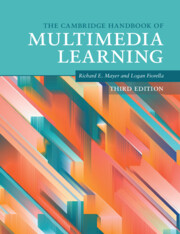Book contents
- The Cambridge Handbook of Multimedia Learning
- The Cambridge Handbook of Multimedia Learning
- Copyright page
- Contents
- Figures
- Tables
- Contributors
- Preface
- Acknowledgments
- Part I Background
- 1 Introduction to Multimedia Learning
- 2 Foundations of Multimedia Learning
- 3 Fifteen Common but Questionable Principles of Multimedia Learning
- 4 Research Methods in Multimedia Learning
- Part II Theoretical Foundations
- Part III Basic Principles of Multimedia Learning
- Part IV Principles for Reducing Extraneous Processing in Multimedia Learning
- Part V Principles for Managing Essential Processing in Multimedia Learning
- Part VI Principles Based on Social and Affective Features of Multimedia Learning
- Part VII Principles Based on Generative Activity in Multimedia Learning
- Part VIII Multimedia Learning with Media
- Author Index
- Subject Index
- References
4 - Research Methods in Multimedia Learning
from Part I - Background
Published online by Cambridge University Press: 19 November 2021
- The Cambridge Handbook of Multimedia Learning
- The Cambridge Handbook of Multimedia Learning
- Copyright page
- Contents
- Figures
- Tables
- Contributors
- Preface
- Acknowledgments
- Part I Background
- 1 Introduction to Multimedia Learning
- 2 Foundations of Multimedia Learning
- 3 Fifteen Common but Questionable Principles of Multimedia Learning
- 4 Research Methods in Multimedia Learning
- Part II Theoretical Foundations
- Part III Basic Principles of Multimedia Learning
- Part IV Principles for Reducing Extraneous Processing in Multimedia Learning
- Part V Principles for Managing Essential Processing in Multimedia Learning
- Part VI Principles Based on Social and Affective Features of Multimedia Learning
- Part VII Principles Based on Generative Activity in Multimedia Learning
- Part VIII Multimedia Learning with Media
- Author Index
- Subject Index
- References
Summary
This chapter describes diverse research methods to study multimedia learning. In light of the wide range of methods to study learning with multimedia and to stay in line with the focus of this Handbook, I target experimental research where a variation of multimedia design is tested against (at least) a control design. Thus, I omit case studies, technical developments, design-based research, etc. Moreover, I only take into consideration research in which the main dependent measure was some sort of learning outcome, such as performance, retention, or transfer. In addition, I look into variables mediating the way to this learning outcome. In this way I come to the following structuring of measures: tests that a priori capture characteristics of learners, measures that online trace the process of learning, self-reports of how learners experienced this learning, and learning outcome measures. For each type of measure, I provide a description and concrete examples of their use in multimedia research. Lastly, I explore thus far, less-frequently used methods in multimedia research, that have, however, the potential to shed new light on multimedia learning.
Keywords
- Type
- Chapter
- Information
- The Cambridge Handbook of Multimedia Learning , pp. 41 - 54Publisher: Cambridge University PressPrint publication year: 2021
References
- 2
- Cited by



